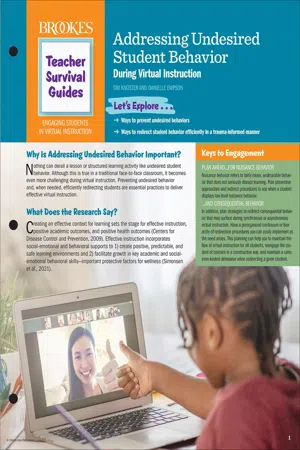
Addressing Undesired Student Behavior During Virtual Instruction
- 6 pages
- English
- ePUB (mobile friendly)
- Available on iOS & Android
Addressing Undesired Student Behavior During Virtual Instruction
About this book
Enrollment in virtual and blended schools is on the rise—introducing new challenges with student engagement, social–emotional wellness, and behavior management. Help is here with this laminated quick–guide, one of four concise Teacher Survival Guides on Engagement of Students in Virtual Instruction. This how–to guide walks educators through four essential strategies for preventing and addressing undesired behavior, keys to success that can be especially challenging in online learning environments. Tim Knoster and Danielle Empson give teachers clear, research–based guidance on preventing undesired student behaviors before they start. Teachers will also learn how to efficiently redirect undesired student behavior—both nuisance-level and more consequential behavior—in a trauma–informed manner. GET THE COMPLETE SERIES: The four Teacher Survival Guides on Engagement of Students in Virtual Instruction are filled with the ready–to–use guidance K–12 teachers need to boost engagement, student wellbeing, and positive behavior in virtual settings. Packed with bite–sized nuggets of insight—including keys to engagement, teaching tips, proven strategies, and FAQs—these laminated, six–panel guides will help any teacher take immediate action to support their students' academic, social–emotional, and behavioral success. Learn more about the other quick-guides in the series: Enhancing Student Engagement by Virtually Establishing, Teaching, and Reinforcing Desired Behavior
Engaging Students in Virtual Instruction Through Opportunities to Respond
Building Relationships With Students and Caregivers to Enhance Learning Through Virtual Instruction
Frequently asked questions
- Essential is ideal for learners and professionals who enjoy exploring a wide range of subjects. Access the Essential Library with 800,000+ trusted titles and best-sellers across business, personal growth, and the humanities. Includes unlimited reading time and Standard Read Aloud voice.
- Complete: Perfect for advanced learners and researchers needing full, unrestricted access. Unlock 1.4M+ books across hundreds of subjects, including academic and specialized titles. The Complete Plan also includes advanced features like Premium Read Aloud and Research Assistant.
Please note we cannot support devices running on iOS 13 and Android 7 or earlier. Learn more about using the app.
Information

Prevent Undesired Behavior by Precorrecting
FAQS
Keys to Engagement


Gauge Your Response Through an Equity Lens
Table of contents
- Cover
- Why Is Addressing Undesired Behavior Important?
- STRATEGY 1: Prevent Undesired Behavior by Precorrecting
- STRATEGY 2: Gauge Your Response Through an Equity Lens
- STRATEGY 3: Redirect Nuisance Behavior
- STRATEGY 4: Redirect Consequential Undesired Behavior
- About the Authors
- References
- Copyright